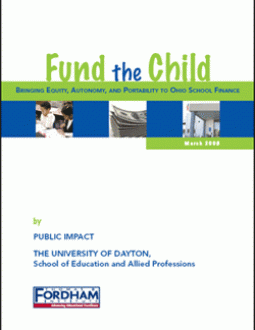Ohio can boast of praiseworthy gains over the past decade in making school funding more equitable across districts. The next step must be to make funding fairer within districts, according to this study from the Thomas B. Fordham Institute. This imperative also gives Ohio the opportunity to modernize its public-education finance system to keep pace with powerful changes in the education system itself.
To mitigate the school-finance inequities that remain within districts and gear school funding toward the realities of student mobility, school choice and effective school-based management, the report recommends that Ohio embrace Weighted Student Funding (WSF).
Weighted Student Funding makes equity a reality within districts by allocating resources based on the needs of individual students and by sending dollars directly to schools rather than lodging most spending decisions at the district level.
Today, one in seven Ohio students is educated in a school other than their neighborhood district school. Families increasingly change schools during the course of their children's K-12 careers and more and more of them select options other than their assigned district schools, options that include magnet schools, community (charter) schools, and STEM (Science, Technology, Engineering, and Math) schools. Yet there is no mechanism to ensure that as students move from one school to another, resources move, too.
And while Ohio has made a start at modifying education funding according to the singular needs of individual children, most school dollars are doled out without regard to student circumstances and needs-and even when they are, districts may not channel the additional dollars to the school that a child actually attends.
Weighted Student Funding addresses these problems:
- Dollars follow students to the public schools that they actually attend. A high-poverty student, for example, would be funded in whatever school he or she enrolls in--and that money also would move with the student to a different school;
- Spending is calibrated to each student's needs. It costs more to educate disadvantaged, disabled, and non-English speaking youngsters. WSF allots resources accordingly; and
- Principals gain the flexibility to spend their schools' budgets in ways that maximize results for their pupils. Funds arrive at schools as real dollars, not staff positions or categorical programs.
Fund the Child was written by expert analysts at the University of Dayton's School of Education and Allied Professions and at Public Impact, a North Carolina-based education policy consulting firm.
The report's conclusions and recommendations affirm those of thoughtful groups that have already urged Ohio to move toward Weighted Student Funding. These include McKinsey & Company, Achieve, and the School Funding Subcommittee of the State Board of Education.


